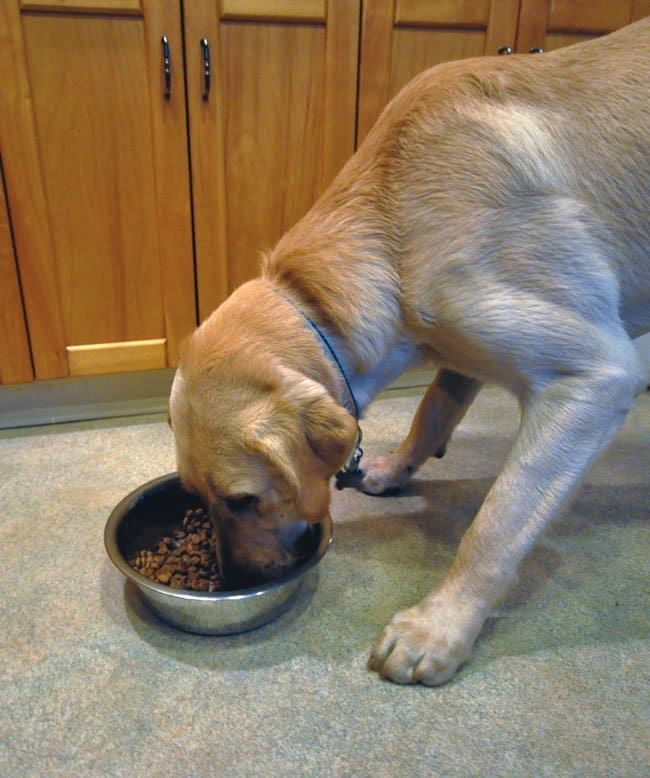Each and every one of the six people who adopted the puppies I fostered recently asked me the same question: “How much should I feed him?” I was surprised the first time, and cracking up by the last time I heard the inevitable question. “How much to feed” is not something I’ve ever struggled with or worried about. And yet, it must be a problem! Just look at the dogs at your local park or in the waiting room at your vet’s office – most of them are quite frankly obese! So here a few basic guidelines.

1. Use the “recommended feeding amounts” on the label of your dog’s food as a starting point, not a fixed rule.
Calorie calculations and recommended amounts to feed are always an estimate, as the caloric needs of individual dogs can vary significantly based on activity level, metabolism, and other factors. The only way to know for sure how much food or how many calories your dog needs is to carefully monitor and keep track of the amount you feed her, watch her weight closely, and adjust the amount you feed as needed to keep her at, or help her reach, her ideal weight.
2. Use a measuring cup or scale.
If you measure the amount of food you feed in cups, be sure to use a measuring cup, not just any cup, which might hold more or less than the regulation 8 fluid ounces. Better yet, get a small kitchen or postal scale and measure the food by weight, which is more accurate. This is especially useful for those of us feeding small dogs; even a few kibbles’ difference – which you can’t really appreciate when they are in even a measuring cup – can make a big difference in the weight of a small dog.
3. Do a little math (it won’t kill you, we promise).
If you feed a homemade diet and calculate the amount to feed as a percentage of your dog’s body weight, remember that small dogs eat a larger percentage of their weight than larger dogs do. The amount of fat in the diet will significantly affect the number of calories provided; it’s best to feed only lean meats (no more than 10 percent fat) to most pet (non-athlete) dogs. Dogs fed grains and other starchy carbs will usually eat more food by weight than those fed primarily meat and animal products (which are higher in fat).
4. Add up the extras (and consider eliminating most of them).
If your dog is any fatter than lean, he’s getting too many calories. Those of us who feed dry dog food (a nutritionally very dense food) may object when our veterinarian says, “Feed him less!” – especially when it seems we are feeding him practically nothing at all. But don’t forget to take into account the calories your dog gets from treats, chews, leftovers, and supplements (particularly oils, which provide 40 calories per teaspoon).
Many treats do not show calories on the label, so if you’re concerned, contact the company to find out. Some examples: Greenies have 25 to a whopping 272 calories each (depending on size), while Milk Bone dog biscuits range from 10 to 225 calories. Bully sticks may have about 29 calories per inch, while rawhide may have 80 calories per ounce!
If you find you have to feed much less than the amount of food recommended on the label to keep your dog at her proper weight, the odds are she’s getting significant calories from these other sources, which may be limiting the nutrients that she needs. (If that’s not the case, consider asking your vet whether it might be worth testing your dog for hypothyroidism.)
5. Add real food if you want – but the right foods.
When adding “human” foods to a commercial diet, you can generally give as many non-starchy vegetables as you want, including carrots, broccoli, zucchini and other summer squashes, green beans, and all kinds of leafy greens. These foods are low in calories but provide valuable antioxidants and phytonutrients, and may help your dog feel fuller. Remember that vegetables must be either cooked or pureed in order to be digestible by dogs, but there’s no harm in giving whole, raw veggies as a treat, such as carrot sticks, green beans, or zucchini slices.
Other good choices for added foods without a lot of added calories include skinless chicken breast, low-fat or nonfat yogurt and cottage cheese, and sardines packed in water, not oil. Canned pumpkin and sweet potato in small amounts can be good for digestive health.
Remember, studies have shown that thin dogs live significantly longer, and their health and mobility stays good later in life. If you really love your dog, keep her lean!
Thanks to WDJ contributor Mary Straus for help with this article.






